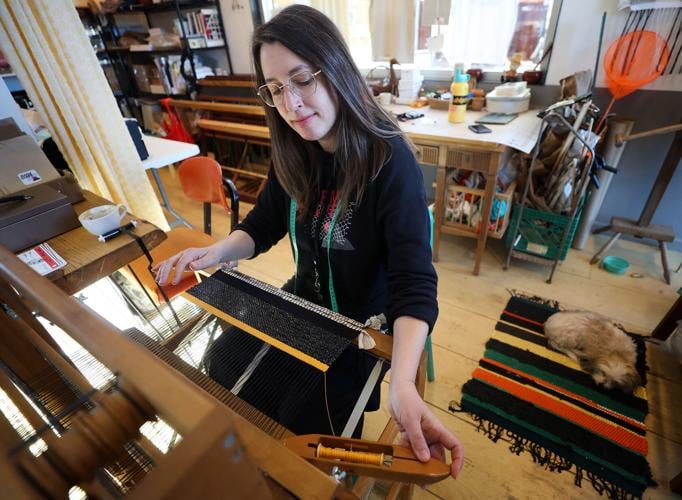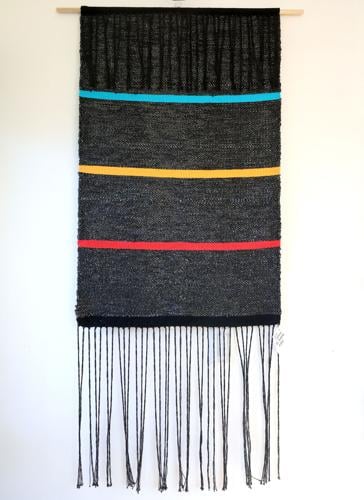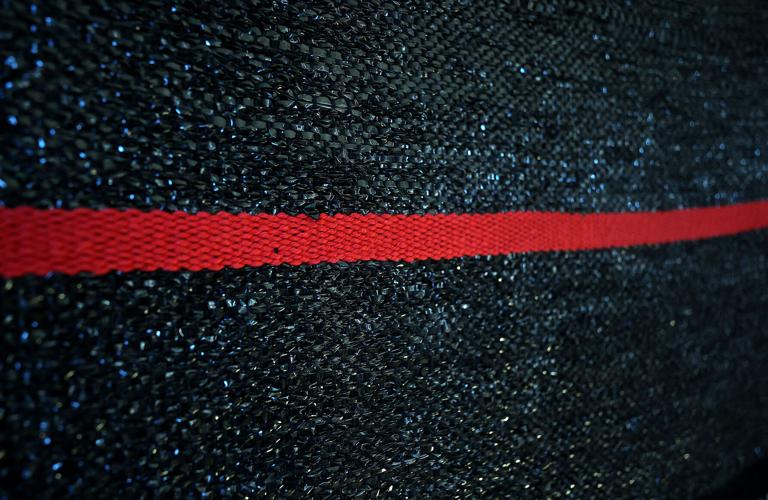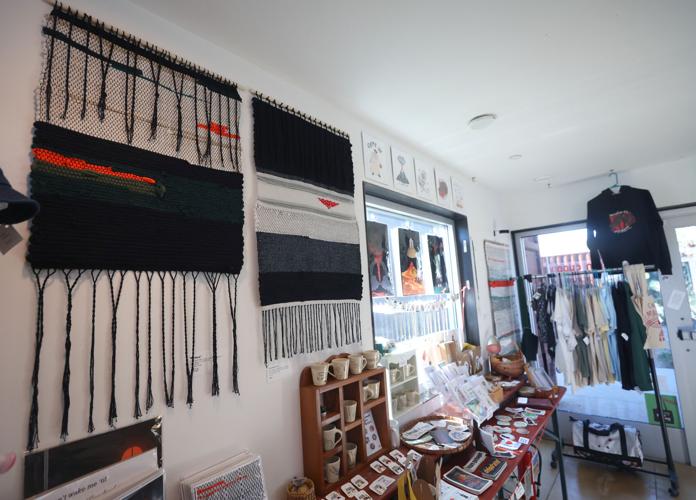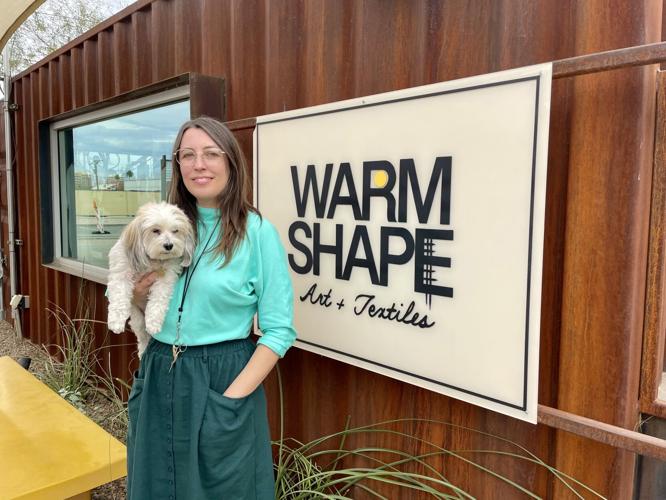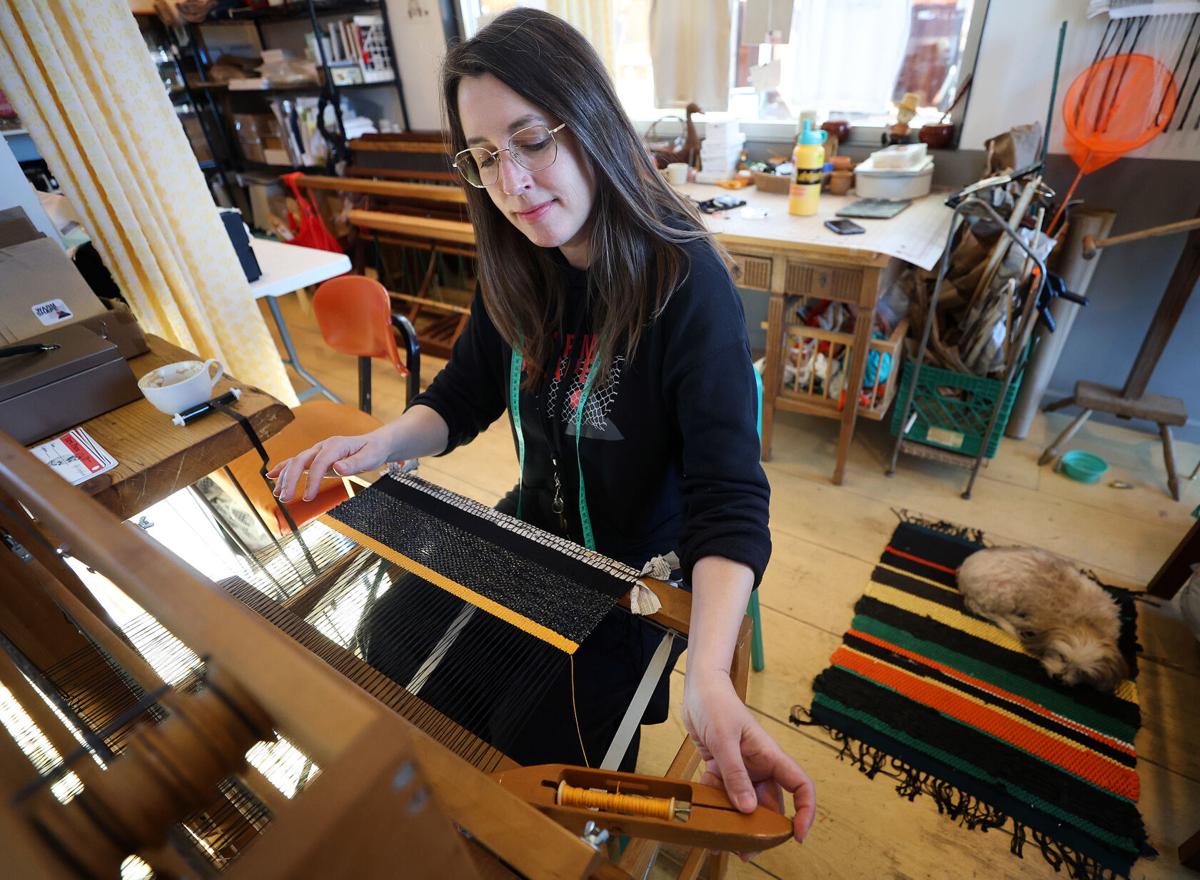The art of weaving is said to be one of the oldest forms of crafting in the world.
For thousands of years, communities and cultures across the globe have utilized weaving to make necessities like baskets, clothing and blankets. But over time, the craft has developed from a means of necessity to an art form used to bring communities together through storytelling.
With simple materials like thread and yarn, weavers have created intricate or even subtle designs that transform stories into something artistic and visual. Now, a local artist is putting a new twist on the historical craft by creating tapestries made from an atypical material — some of your favorite movies on VHS tape.
Linus Schief, a musician, artist and owner of local shop Warm Shape at the MSA Annex, 267 S. Avenida del Convento, is the mastermind behind the unique tapestries. As a lifelong artist and skill collector, Schief began weaving around 10 years ago but recently started to experiment weaving with film.
“I was trolling the Goodwill bins, which is this by-the-pound facility for raw materials and I came across a VHS tape of ‘A Little Princess’ and I was like, ‘I do not care about this movie. I don't feel bad about destroying it to weave with it,’” she said. “So I ended up taking it apart and weaving it. And it turned out so beautiful. I was like, ‘Whoa, this is crazy because weaving, historically, is a storyteller or it's a way of communicating. And now I'm making an object out of a story that already exists, that's encoded within the tape itself.’”
“So it's a linear story, but then I'm weaving it into this object and then you're looking at it on the wall as if you're looking at a screen and it's communicating something new and it's not linear.”
Some movies that Schief has converted into film tapestries include “The Wizard of Oz,” “Star Wars: The Empire Strikes Back,” “The Sound of Music,” “This Is Spinal Tap” and “The Fast and the Furious.”

A completed tapestry made from a VHS copy of “Ace Ventura: Pet Detective” hangs in Linus Schief’s shop, Warm Shape.
While the tapestries are intricate, the designs offer subtle hints of the movies in which they are handcrafted. For example, with “The Fast and the Furious” tapestry, Schief wove the tapestry to resemble main character Dom Toretto’s black 1970 Dodge Charger R/T.
“I was like, ‘I want to make the piece kind of resemble that car,’ not overly, but conceptually,” she said. “So I wove in some silver because the tape is already black and shiny. So I want some silver details at the top and the bottom, thinking of it as, like, the bumper and the fender. I also wove in two parallel black lines with darker black thread to be the railroad tracks down toward the bottom as if you're watching the whole movie from top to bottom and then at the end is the railroad tracks (scene).”
Additionally, Schief felt like the film’s soundtrack was a “really big piece of the movie,” so she recorded the soundtrack on her tape deck and then took the brown cassette tape and wove that into the tapestry as well, adding a touch of warmth to the overall cool-toned tapestry.
One of Schief’s most recent weavings used a “Homeward Bound” VHS that she created for four siblings who grew up watching the movie. She split it into four identical pieces for each sibling.
“I made those four pieces and the recipient teared up when I delivered them,” she said.
The emotional reaction from the siblings’ tapestry isn’t the first time Schief has received a touching reaction from her work. As an artist who works with various media including plastic bags, old textiles and other non-traditional materials, Schief has created some pretty unique pieces with interesting backstories.

A portion of a tapestry made from a VHS tape of "Ace Ventura: Pet Detective" hangs in Linus Schief's shop, Warm Shape.
Aside from the reactions to her VHS tapestries, a standout moment was when she completed a commission from a woman who wanted to preserve her two sons’ baby outfits that had been sitting in boxes for years.
The woman, who was a bit nervous to hand over the infant outfits, was assured by Schief that the finished product would be worth it.
“It's better that they are hanging up and not in this box forever,” she said. “And when it came time for me to actually cut them up, I was really scared. I was like, ‘What if I really screw this up and then she hates it and then I've ruined her baby clothes?’ But then she came and saw what I made. She cried and she hugged me.”
'I like to make something out of nothing.'
Unsurprisingly, the process behind Schief’s weavings is tedious.
With her signature VHS tapestries, she begins the process by watching the chosen film through its entirety. While watching, she takes notes, finds inspiration within the movie and develops concepts she can add to the weaving.
From paper, Schief begins the long process of prepping the loom, placing sometimes hundreds of threads through the warp, which lay vertically. Dressing the loom is time-consuming and can take days to finish as she works on the process for a few hours at a time.
Once the prepping is finished, she moves on to the fun part: weaving.
From start to finish, it can take weeks, if not months, to see the completed piece. But it’s all worth it in the end when Schief removes the tapestry from the loom to see the finished product, which she calls her favorite part of the whole process.
“It's been really fun and freeing to just give myself that permission to try things,” she said. “And even when I don't like how they turned out a lot of time, which doesn't happen very often honestly, but when it does, I kind of feel like, ‘Well, I'm not the ultimate decider.’ Other people might like this. And usually, those kinds of projects end up having some kind of synchronicity in life or some real relationship to something going on in the world or it feels really intuitive.
“For as detail-oriented and fussy as weaving can be, there is a lot of room for errors. I welcome them. I welcome mistakes. And just trusting myself during the process of just winging it.”
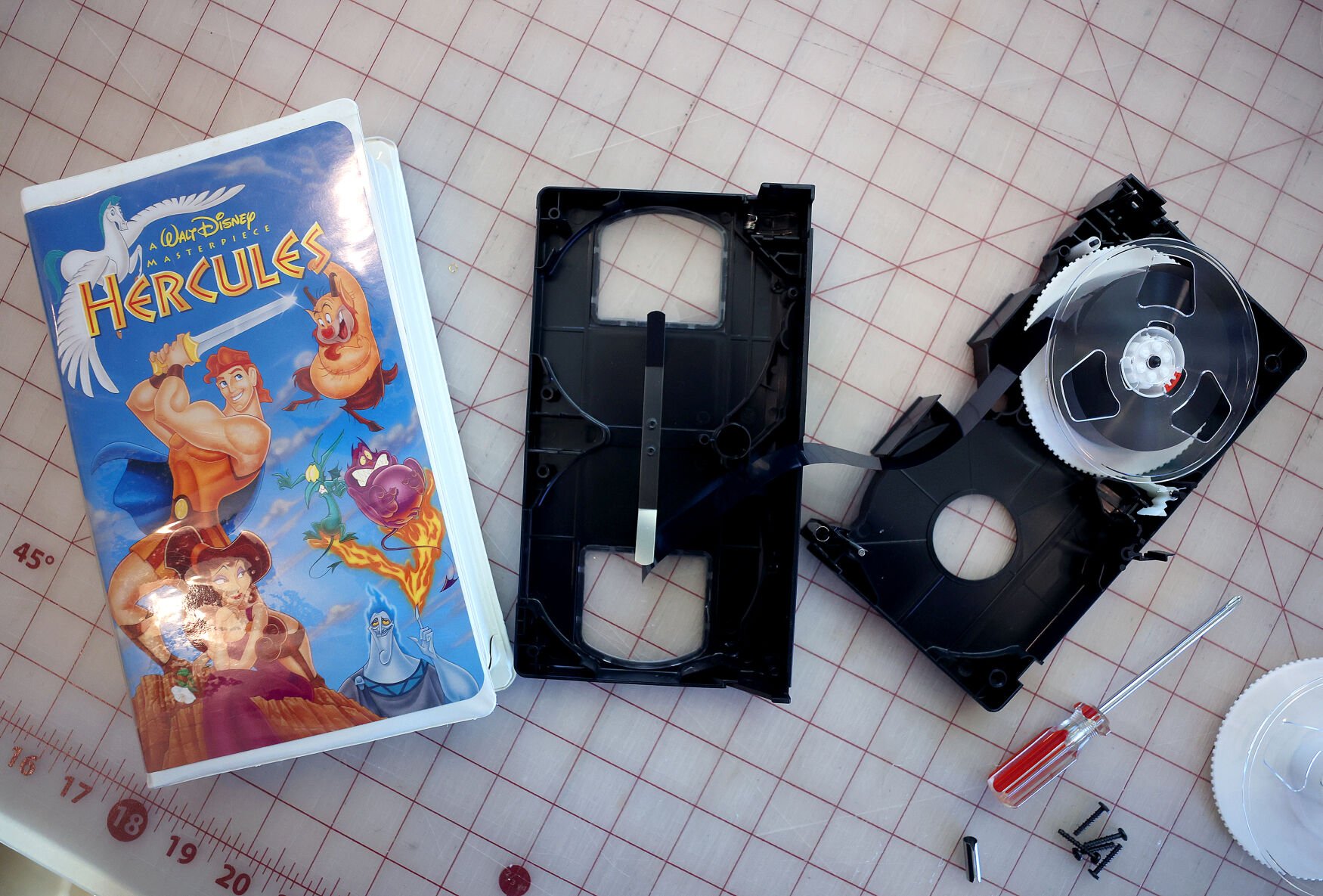
Linus Schief removes film from VHS tapes and weaves the film using a loom. A customer has commissioned Schief to weave a tapestry from the Disney film “Hercules.”
Most of Schief’s weavings are about 24 inches wide. The length can vary depending on the length of the VHS tape. She estimates that the tapestries weigh less than a pound.
You’ll often find Schief weaving at her retail shop and textile workshop, Warm Shape, at the MSA Annex with her furry companion Lady by her side. Schief opened the shop last year when a vacancy at the Annex presented itself at the right time, she said.
“A lot of times when people come in, they think they're interrupting me because I'm working in there. But I don't want people to feel that way,” she said. “So please, come in and check out what I've made. It's like a gallery, a kind of workshop, a retail store and artist’s Q&A, all at once, all the time.”
Around six years ago, Schief loaded up her truck with her belongings (and Lady) and drove away from Washington where she had lived for the last 15 years. She didn’t know she would end up in Tucson but she knew she wanted to live in the desert.
“I just realized that I needed to get out of the Pacific Northwest and get some sun,” she said.
Once here, she ran Linus Textiles out of local collective Subspace, participated in local markets and even worked at Exo Roast Co. Her work in the coffee industry partially inspired the name of Warm Shape.
“I worked in specialty coffee for a lot of years and for a while was doing a pour-over pop-up at my old studio space at Subspace in Tucson. It was winter and pretty cold in the warehouse, so I called it 'Warm Shape' for how the coffee cup felt in my hands,” Schief said in an email. “When it came time to name my art shop at the Annex, I recycled Warm Shape since most of my art is about volcanoes, eggs, animals, the sun, humans and sports. All those things felt like they could live under the umbrella of Warm Shape.”

Linus Schief describes her space Warm Shape as “a gallery, a kind of workshop, a retail store and artist’s Q&A, all at once, all the time.”
Looking for a long-term career, Schief then tried her hand at computer programming but quickly realized she hated it. She needed to do something more than sitting at a computer all day. She needed to do something more with her hands.
After realizing she didn’t want to be a computer programmer full-time, she decided to fully pursue art.
“Weaving has so much in common with computer coding,” she said. “You're embedding a surface with information. It's all embedded throughout, it's encoded and it's a storyteller.”
Now that Schief’s passion for weaving (and design) is a full-time gig, she has even bigger plans for her shop and work. She hopes to host events at Warm Shape including puzzle nights and “movie watching” get-togethers where the VHS tape tapestries will hang for the allotted runtime of the movie and people can “watch” the movie, complete with popcorn and all.
Schief recently welcomed more artists into the shop as a way to connect with local makers and promote community collaboration — something she plans to continue in 2024.
“It feels good, too, because my work is a lot about connection and community and having fun,” she said. “There are a lot of times where people come in, strangers come in, and pretty soon we're crying together or we're holding hands or we're connecting about things. It's not like you're just walking into a store of products for your home or something. Everything has a story. Everything's specific. And I used to think ‘Is this gonna resonate with people?’ I'm such a weirdo. But then it turns out, I'm not a weirdo. I'm just like everybody else. And I'm just voicing things that we all experience or can relate to.”
“So then I was like, ‘Well if my story is all about connection, why am I alone back here? Why am I so often just alone back here toiling and worrying?’ Then I opened it up to include more women, more people, more artists. So far, it's turned out to be women and femmes who are joining me and that just feels very right to me. Let's cultivate this warm vibe. We're all warm shapes, we should be together and we're better together.”
Schief also hopes to eventually expand and have a larger workshop area for herself and other Warm Shape artists.
“It (tapestries) doesn't have to be this precious garment,” she said. “It doesn't have to be a beautiful woolen scarf. I weave with garbage. And that's so fun for me because I like to make something out of nothing.”
For more information about Linus Schief or Warm Shape, check out her website.

Linus Schief and her dog, Lady, pose for a photo outside of her shop, Warm Shape, at the MSA Annex on Dec. 19, 2023.


